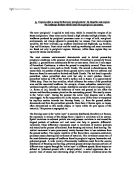Explain what is meant by the term 'periglaciation' - Describe and explain the landscape features which result from periglacial processes.
- Explain what is meant by the term ‘periglaciation’. B. Describe and explain the landscape features which result from periglacial processes.
The term ‘periglacial’ is applied to land areas, which lie around the margins of ice sheets and glaciers. These areas can be found in high latitudes and high altitudes. The landforms produced by periglacial processes occur in a range of cold, non-glacial environments, not always adjacent to present-day ice masses. Two main examples would be, the Polar lowlands, e.g. southern Greenland and Highlands, e.g. Rockies, Alps and Himalayas. Frost action and the resulting weathering and mass movement are found not only in periglacial regions. However, within these regions they are especially intense and dominant.
The most common environmental characteristic used to delimit present-day periglacial conditions is the presence of permafrost. Permafrost is perennially frozen ground, i.e. ground frozen continuously for two or more years. There are 3 main types of Permafrost: Continuous, is where the ground is completely covered. These areas are usually found in areas such as North Alaska. The second is discontinuous; this means there are patches of deeply frozen ground next to areas that are unfrozen and these are found in areas such as Iceland and South Canada. The last band is sporadic permafrost, where permafrost does exist but only in small patches. Overall, permafrost makes up 25% of the Earth’s surface and in Russia it is approximately 1500m deep. There are key variables, which influence the nature of the permafrost zone and the associated landforms. For example, climate, subsurface materials (soil, weathered regolith, rock type), amount, distribution and state of water (liquid or solid, i.e. frozen as ice), because the behaviour of water and ground ice can affect the volume and therefore pressure placed on the surrounding ground. This usually occurs in the ‘active layer’. During the summer the active layer deepens and is often waterlogged. As the temperatures fall in the autumn, some of this water is transported by capillary suction towards two freezing fronts, i.e. from the ground surface downwards and from the permafrost upwards. Once there it freezes again, as lenses, often characterised as thin needle shapes, or layers within the pore spaces of the materials. This process is segregated ice.







